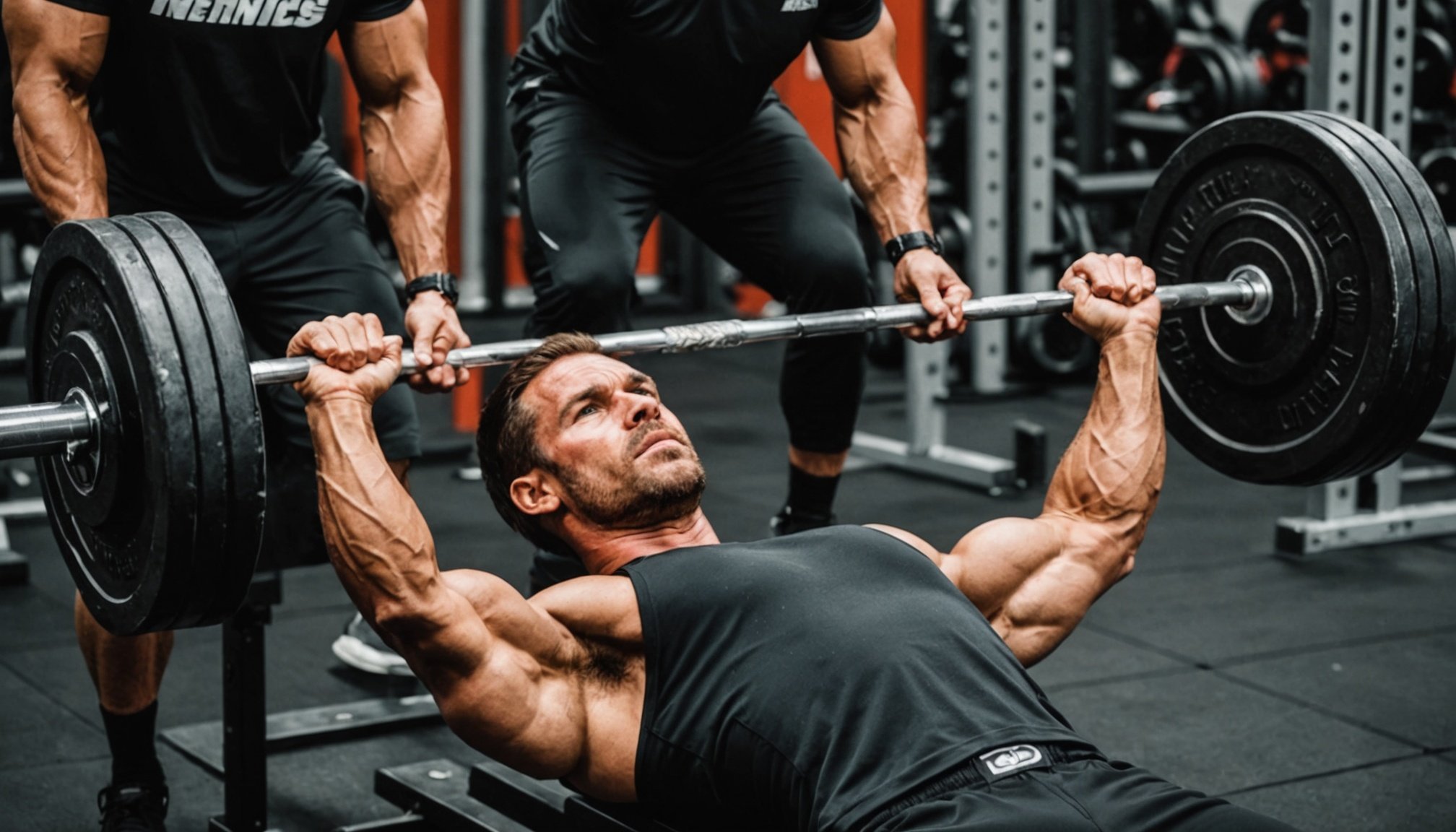Importance of Warm-Up Routines for Bench Press Performance
Warm-up routines play a critical role in enhancing both muscle flexibility and strength. When you engage in a proper warm-up, your muscles gradually adapt to increased demands, improving elasticity and reducing the risk of injury. This preparation is integral to executing a successful bench press.
An effective warm-up routine should increase body temperature, which naturally enhances muscle performance. As muscles warm up, they become more pliable, thereby aiding in achieving optimal bench press performance. With improved flexibility and muscle activation, athletes can exhibit greater force and lift heavier weights with confidence.
The connection between a thorough warm-up and improved bench press metrics is not solely based on flexibility, but also involves neurological aspects. By priming the neuromuscular system, athletes can achieve better muscle coordination and recruitment. This translates to more controlled and powerful lifts.
Injury prevention is a significant benefit of incorporating adequate warm-up routines. Preparing the body through gradual exercises lessens the strain placed on muscles and joints during heavy workouts. Consequently, warm-ups serve as a proactive measure to safeguard against potential injuries that could otherwise impair one’s fitness journey.
In parallel : Exploring the Impact of High-Protein Diets on Kidney Health for Bodybuilders: What You Need to Know
Ultimately, prioritising warm-up routines ensures enhanced performance and long-term wellbeing during bench press exercises.
Muscle Groups Targeted in Bench Press
Understanding the bench press involves examining the various chest muscles and shoulder engagement.
Primary Muscles Involved
The pectoralis major stands central to the bench press. As the largest of the chest muscles, it plays the primary role in pressing movements. This muscle is crucial for achieving the upward thrust required in a successful lift.
Supporting Muscles
Beyond the chest, the triceps activation and deltoids have significant roles. The triceps, located at the back of the upper arm, are responsible for extending the elbow joint. This action aids in the pressing phase of the exercise. Meanwhile, the deltoids, or shoulder muscles, provide the necessary support to stabilise and guide the lift effectively, ensuring that shoulder engagement is optimised.
Importance of Muscle Activation
Proper muscle activation sets the foundation for a strong lift. Engaging stabiliser muscles before lifting is critical to maintaining a safe and effective form. These muscles ensure control and precision during the movement, reducing the risk of injury and enhancing overall performance. Activation exercises for these muscles can also improve lifting endurance and strength.
Effective Warm-Up Routines for Bench Press
Before hitting the weights for your bench press workout, it’s crucial to engage in warm-up exercises to enhance your performance. These routines not only prepare your body but also prevent injury, ensuring a more effective strength training session.
Dynamic Warm-Up Exercises
Dynamic warm-ups are designed to increase blood flow, heart rate, and muscle temperature. They involve movements like arm circles and torso twists. These exercises mimic the movement patterns you’ll be performing during the bench press. By incorporating these dynamic movements, you increase your range of motion and stimulate your nervous system for optimum performance enhancement.
Static Stretching Techniques
While dynamic exercises are great before lifting, static stretching plays a role in post-warm-up recovery. Holding stretches for muscle groups engaged in bench press can aid in relaxation and increase flexibility. This contributes to minimizing muscle tightness and assists in a more fluid weightlifting experience during your strength training routine.
Activation Drills
Activating specific muscle groups is essential for a successful bench press. Band pull-aparts are an excellent drill to engage the shoulders and upper back, ensuring these muscles are primed to support the pressing motion. Incorporating drills like this into your warm-up routine can optimize your muscle engagement, preparing you for a safe and effective workout session.
Personalized Warm-Up Strategies
When designing a personalized warm-up routine, individual fitness levels should be a primary consideration. Each athlete has unique physical capabilities and limitations, which demand tailored approaches. To effectively prepare the body for exertion, warm-up routines can be adjusted to suit personal needs. This customization starts with assessing one’s athlete-specific requirements.
For athletes with prior injuries, warm-up adjustments are crucial. These individuals need careful attention to mitigate further damage. By focusing on gentle, specific muscle activation, warm-up adjustments can prevent exacerbation of old injuries while preparing the athlete for more intensive activity. Ensuring these routines are adequately personalized helps maintain longevity in their sporting careers.
Monitoring personal performance metrics plays a significant role in tailoring warm-ups effectively. By tracking parameters like heart rate, flexibility, and endurance, athletes can identify areas that need particular focus or improvement. Such data-driven insights lead to better crafted athlete-specific warm-ups, bolstering performance and reducing risk of injury.
In essence, personalized warm-up strategies maximise an athlete’s potential by accommodating their unique needs. Through careful adjustments and consideration of performance metrics, optimal warm-up adjustments can be made, ensuring both safety and enhanced athletic performance.
Tips for Maximizing Warm-Up Effectiveness
A warm-up is critical in bench press training for a noticeable performance boost. Timing, mobility, and hydration are integral components, improving the quality and benefits of your exercise session. Thoughtful preparation can lead to substantial gains in strength and endurance.
Timing Your Warm-Up
Determining the optimal timing for your warm-up can significantly impact your training. Ideally, aim for a duration of 10-15 minutes before lifting. This window helps prepare your muscles and joints without causing fatigue. A properly timed warm-up boosts blood circulation and increases muscle temperature, leading to improved performance. Over time, you’ll notice enhanced endurance and strength.
Incorporating Mobility Work
Integrating mobility work into your routine is pivotal. Mobility exercises enhance your range of motion, reduce injury risks, and support heavier lifts. Focus on dynamic stretches such as arm swings, thoracic rotations, or shoulder circles specifically for bench press training. These exercises activate primary muscle groups and promote flexibility, ultimately resulting in a substantial performance boost.
Hydration and Nutrition Factors
Proper hydration and nutrition are indispensable for effective strength training. Ensuring adequate fluid intake before and during your workout sustains energy levels and optimises performance. Prior to lifting, consume easily digestible carbohydrates for quick energy. Balancing these factors can make a significant difference, contributing to an overall successful training session.
Nutrition and Recovery Post-Warm-Up
Understanding the significance of nutrition for athletes revolves around enhancing energy levels and optimizing recovery. Adequate pre-workout meals serve as a critical component, fuelling physical exertion and maintaining stamina. Carbohydrates supply immediate energy, while a blend of proteins supports muscle preservation during exercise.
Transitioning into recovery strategies, post-exercise nutrition is indispensable for repairing and building muscles. Consuming protein-rich meals promptly after a workout helps in mitigating muscle breakdown while promoting growth. Integrating natural fats into your meal can facilitate nutrient absorption, adding another layer to muscle repair efficiency. Performance nutrition involves balancing macronutrients to ensure sustained energy release and minimizing fatigue.
Meal timing plays a crucial role in aligning with your workout schedule. For optimal outcomes, it’s generally recommended to eat about 1-2 hours before exercising to allow for digestion and nutrient availability. Post-lift, a nourishment window of approximately 30-60 minutes is ideal to uplift muscle recuperation, exploiting the body’s heightened capacity to utilize nutrients.
In practice, precision and consistency in dietary strategies can markedly boost athletic performance. Recognizing and implementing these key aspects of nutrition help athletes achieve the energy and recovery needed to meet their performance goals.











